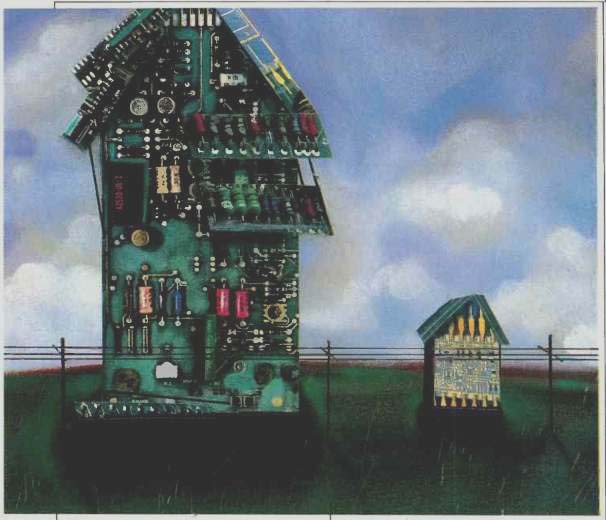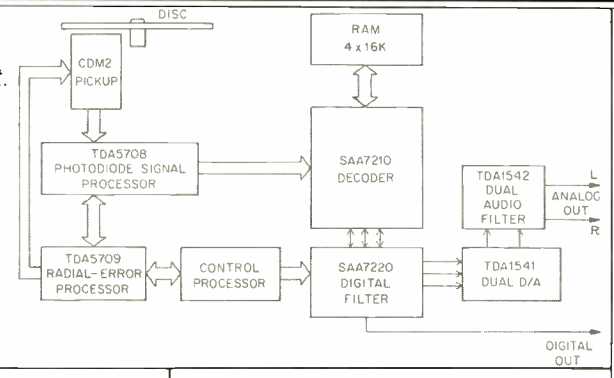CHOICE CHIPS

The economics of digital audio technology is considerably different from that of analog audio. One reason is that digital more readily lends itself to integration. When circuitry is reduced to a chip, several interesting things happen. First, everything gets a lot smaller. Instead of a king sized circuit board populated with several thousand transistors and other discrete components, you've got some thing the size of a caterpillar (the insect, not the earth-moving tractor). Furthermore, power consumption is dramatically reduced, thereby decreasing the size of power supplies or batteries.
But cost, the bottom line, is the most interesting asset of integration. While the development cost of a new chip can be very high, the manufacturing costs are quite low. If the development costs are amortized over the market life of the chip, and divided over the number of chips sold, the cost per chip is about as small as the microcircuitry itself. In addition, the costs of labor, packaging, and shipping of the finished product are all lower. The result Is a product that is smaller, lighter, less sensitive to environmental changes, less power-hungry, more reliable, and cheaper--all thanks to chips.
Compact Disc players exemplify the benefits of digital micro-electronics. A CD player without chips would probably be the size of a Winnebago motor home, consume the power required for a Grateful Dead concert, and cost more than you could ever afford; it wouldn't sound very good, either. Its hundreds of circuit boards would be extremely unstable, particularly when the temperature changed. Even with a full-time engineer crawling around in side to adjust potentiometers, fluctuations would make a joke of operating tolerances.
It follows that manufacturers are anxious to reduce CD player circuitry to the smallest possible number of chips; that objective, in fact, is shaping the evolution of player design. The most recent step forward in this quest comes from Philips, co-inventor of the CD system. Philips has developed several new chips specifically for the CD (and CD-ROM) system. The new chips, and the rest of the circuitry for a complete CD player, are shown in Fig. 1. The three principal decoding chips, SAA7210, SAA7220 and TDA1541, replace six earlier chips. The SAA7210 handles demodulation, error correction, and basic interpolation. The SAA7220 contains circuitry for enhanced interpolation and a phase-linear digital FIR (finite-impulse response) filter. The TDA1541 is a dual 16-bit D/A converter chip.
For design flexibility, the I2S (inter-IC signal) format is used between the SAA7210, SAA7220, and TDA1541 chips; this is a bus with separate lines for serial data, left-right channel selection, and clock (timing) data. Using this bus, the SAA7210 and TDA1541 could be connected directly, omitting the SAA7220; this would allow, for example, a low-cost player to skip digital filtering and use a downstream, brick-wall analog filter instead.
Of course, the time and trouble required to compress circuitry into fewer chips is worthwhile only if the opportunity to provide better performance is seized. In this case, the three new de coding chips offer some significant improvements.
One aim of the IC designer is to reduce the number of external components required by the chip. In the case of the SAA7210, its predecessor had nine resistors, five capacitors, a varicap diode, and a balanced differential filter. Messy. The new chip requires only a single resistor and two capacitors outboard.

Fig. 1--Block diagram of a CD player using the new Philips chip set.
Part of the SAA7210's job is to process subcode information-the non-audio data representing track numbers, playing times, titles, etc. In the old design, the control processor wasted a lot of time trying to process every bit of subcode as fast as it arrived.
Now, the SAA7210 decoder collects the subcode data and sends it to the processor only when the processor re quests. If the processor requires only a portion of the subcode, such as a track number (contained in the first 16 bits of the frame), it can reset the SAA7210, returning it to subcode collection.
The SAA7210 is also responsible for a share of the chip set's error handling-in this case, error correction, using the Cross Interleave Reed-Solomon Code (CIRC). The CIRC is standard for all Compact Discs and players, but the SAA7210, unlike other de coders, uses adaptive error correction to discriminate among types of error.
This makes better use of the CIRC capability, permitting correction of longer burst errors (up to 15 frames versus seven frames for the old decoder) and making corrections more reliable. All decoders use error flags to pinpoint troubled data, but the SAA7210 uses extra flags. The optimum error-correction strategy (out of 60 possibilities) is selected by a flag processor, depending on the type and number of flags raised by disc defects. After-correction flags are generated and compared to incoming flags to fine-tune the strategy. The various strategies are programmed in the SAA7210's ROM and can be altered for non-audio CD applications which might call for different approaches.
The SAA7210 must also communicate with random-access memory (RAM); a FIFO (first-in, first-out) memory is needed to de-interleave data and to buffer data-rate irregularities. The SAA7210 is designed to operate with a 4 x 16K RAM which accommodates 64 frames of data, compared to the old four-frame RAM of first-generation players. Among other benefits, the larger FIFO memory will help smooth data disruptions occurring in car and portable players.
The SAA7220 is a digital filter--essentially a shift register--that moves the data bits along, one bit at a time, to create a comb filter. The shifting creates a time delay; if delayed bits are tapped off and added to original bits, cancellation occurs at selected frequencies. By timing things just right, the appropriate high frequencies are filtered out.
The SAA7220 digital filter chip also does error correction. Those too massive to be corrected by the SAA7210 decoder are passed on to the SAA7220 chip, together with the error flags mentioned previously. An interpolator on the SAA7220 masks uncorrected errors (up to eight samples long, versus one sample for the previous chip set) to create a smooth bridging waveform over the bad samples. When errors are too large for correction or interpolation, the chip repeats the last valid sample until a new one can be found, instead of muting the output as the earlier chips did.
The new filter chip offers several other advantages over its predecessors. The number of taps has been in creased by 24 per channel, to a total of 120. Pass-band ripple has been reduced to +0.02 dB to lessen the possibility of its being audible. (Experiments have shown that pass-band ripple as small as +0.2 dB can be heard.) And the SAA7220 continues in the Philips tradition of four-times over-sampling. The oversampling technique has several advantages, but one of Philips' original reasons for using it-to get 16-bit performance from a 14-bit converter chip-is now gone: The new TDA-1541 is a full 16-bit D/A converter.
An even more significant improvement is that the TDA1541 (which shares with its predecessor a dynamic-element matching design) is a dual D/A chip. Many CD players use a single D/A converter, multiplexed be tween the two stereo channels. This can cause switching distortion and interchannel timing error. If the two channels are mixed after the timing error occurs (as they would be for monophonic listening or for FM stereo transmission), the delay will cause a comb-filter effect, just as it does in a digital filter. But with dual D/A converters, there is no delay between channels. And since the TDA1541 has two such converters on one chip, there is no chance of mismatched performance or thermal drift between single D/A chips. Internal bit-switching is performed with a nicely designed, fast and accurate diode transistor configuration; there's no need for external deglitching circuitry.
The TDA1541 also looks ahead to the possibility of digital signal processing, such as the use of digital tone controls. Such processing increases the dynamic range of the output signal when selected frequencies are boosted. When the 16-bit TDA1541 is coupled to noise-shaping circuits to shift quantization noise out of the audio band, 18-bit resolution can be achieved. The "extra" two bits represent a 12-dB increase in dynamic range, which allows selected frequencies to be boosted 12 dB while still maintaining a 16-bit dynamic range over the audio band.
To wrap things up, the audio output is handled by the TDA1542 filter chip. Digital filtering cleverly shifts frequency components away from the audio band, but they reappear again at higher frequencies. For example, with the four-times oversampling of the SAA7220, a band 44.1 kHz wide is centered around 176.4 kHz. The TDA1542 removes that artifact with an active third-order Bessel filter. It doesn't require any external electrical components so it is physically small, low in noise, free of aging effects, and needs no adjustments.
Obviously, the Philips engineers aren't letting any grass grow under their chips. This new crop offers significant improvements over first-generation chip families. Those improvements reduce player cost, size, and power consumption, while improving reliability and audio performance. Of course, great chips do not always a great player make. You can decide if they do, in this case, when you audition the Philips (Magnavox) CD650, the first Compact Disc player to incorporate the new integrated circuits.
Reference
(1) Electronic Components and Materials, Vol. 6, No. 4 (1984), Philips N.V.
(adapted from Audio magazine, May. 1986)
= = = =